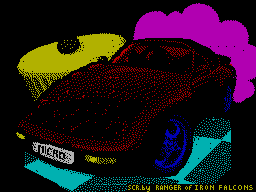|
Optron #06
09 января 1998 |
|
NMI / INT and others - The problems of c interrupts NMI.

/ NMI, / INT, and other
From: Klimov Vassili (# z80, nick BACbKA)
(C) Klimov Vasiliybleme interrupt work on / NMI and all that
with this connected.
I will not grovel for a long time and, therefore, go directly
to the case. So, I would single out The following problems
arise when processing nonmaskable interrupts:
1) preservation of the main registers;
2) determination of IFF (trigger interrupt);
3) the correct operation of the register R;
4) determining the interrupt mode (IM 0
1, 2);
5) unacceptable deterioration of memory cells;
6) to determine the number of the included page;
7) sinronizatsiya with maskable interrupt (immediately and
the screen number);
8) recovery of all memorized and higher launch;
Now everything in detail. Step 1
and 4 are solved not so difficult it here
go about the rest. In order not to spoil the memory, enough for
treatment to a procedure NMI processing to include instead of
ROM shadowing RAM (as suggested Sergei Tyatin), then
program will look like this:
org # 0066
ld (Stack), SP
ld SP, Stack
push AF
ld A, I
push AF
... , And saved
... ; Of registers
... ; Through the stack and op
... ; Definition mode
... ; Interrupt
defs NNNN
Stack defw 0
But that's not all. Case that
after the arrival of NMI and validation (/ M1 OR
/ IORQ) = 0 on the stack is stored return address
in the interrupted program. Sergey said,
that it is difficult to solve. I propose to write the address
is not on the stack, and a pair of 8 bit registers (this is not
is easy, but with a soldering iron to run have :-)) (Rasp:
could you write more specific, as it should be run, and then I
see it only in general terms and reinvent the wheel is not very
hunting).
Now for the expansion port. Apparently, once the Pentagon
declared a standard, then memory expansion up to 512kb Pentagon
should support (for those who do not knows: through bits 6 and
7 of port # 7ffd). But because actually there are machines with
more memory 512kb (I have, for instance, profiles), we urgently
need somewhere to shove, this is not the way (?) appeared bits.
Who has the ideas to write. (Rasp: There is one idea: to use
the 5-th bit port # 7ffd, blocking the port # 7ffd not very
and need - THE PROGRAM Only 48K is not bad going
through the so-called, USR 0). Further, naturally, you need a
port for reading # 7ffd (And if you schityvete return address,
then for him, too, need a port). Here I can offer (all probably
already got) Port # XXfd so as not to conflict with AY
(Rasp: if a program uses virtual kakoenibud ROM or RAM, you can
to make the ports accessible only from this
virtual memory, such as it is
made in the controller Beta Disk). As the comments say that the
Scorpio system ports can be read by AY (although earlier
versions, I think, stood an oak definition pages by comparing
them).
Now let's talk about INT'e. In principle,
here and say there was nothing, just, in my opinion, it is not
used anywhere (there is owing to the shadow monitors). Simply
define the number of cycles between the arrival / INT'a and
when you call / NMI cycle to consider joining maskable
interrupts (along with this can be arranged to determine their
type). About run see below. You may be
question: why is it necessary? And I say: do not
I know:). But this is not a bad thing to ... Yes,
I almost forgot, you can make
interrupt the CPU / NMI through several cycles after the / INT:
reduce the number of calculations, and restart the program it
will be easier.
Now about the last paragraph (honestly
speaking, I was tired of writing it is time
call it a day). Well, I do not know how to do it, I do not
know: (. It all rests in the memory, will likely be no
interruption of the program executed in the ROM (and BASIC48
just there and works), but when run from the shadow RAM to
replace it on the ROM. on that my ideas on this topic had been
exhausted.
Now a few words about "multitasking."
In fact, under the multi-tasking means in parallel (in the
sense of sequential switching between them) the execution of
several programs (see below). In fact, we have several programs
that sit in memory, with a small driver can switch between them
(MagOS). Make it more "cool" MagOS on the Spectrum
help us to ideas that are listed above.
And at the expense of multi-tasking, then the case here
in hardware. Can, in principle, to make that
same MagOS, but the signal / NMI will be generated by a timer
and will not switch screen (how to do it - is another question).
But it's all in the future (and whether it will ...).
So in conclusion, that all ideas,
The above may be freely used, but with only one condition: the
need to standardize everything, otherwise ...
Bye everyone, see you at # Z80 (also waiting
questions and answers in the pages of newspapers).
Those who believe the above nonsense
I can advise to press RESET.
P.S. 9/12/1997 Perm.
P.P.S. KEEP SPECCY ALIVE!!
Other articles:
Similar articles:
В этот день... 29 December